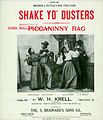S. Brainard Sons
S. Brainard Sons (also known as S. Brainard's Sons and S. Brainard & Sons) was a music publisher, music periodical publisher, and musical instrument retailer based in Cleveland, Ohio and then Chicago, Illinois. The company was founded in 1836 by Silas Brainard with Henry J. Mould.[1] The business published music and songbooks including political and patriotic music.[2] Brainard also published the periodical Western Musical World which was eventually renamed Brainard's Musical World.[3][4] The Library of Congress has a collection of their sheet music.[5] The New York Public Library has copies of their periodical in its collection.[4]
History

Brainard sold Chickering & Sons pianos.[2] It acquired Chicago publisher Root & Cady's plates in 1871[6] after the Great Chicago Fire and eventually relocated to Chicago.
Music periodical
The music journal was published from 1864 until 1895 when it was merged with Etude.[3] The content of each issue included a musician's biography. The publication competed with Root and Cady's Song Messenger of the Northwest.[3]
Karl Merz became an editor of Brainard's Musical World.
Selected publications
- School Chimes, A New School Music Book (1874) written by the hymn composer James Ramsey Murray
- "Weston's March to Chicago" (1867), composed by Edward Mack; publisher: (List of songs about Chicago)
- "Keep the Horse Shoe Over the Door"[7]
- Fanny Crosby's Six Songs by Wurzel (1855):[8] "O How Glad to Get Home",[9] "Honeysuckle Glen",[10][11][12] "The Church in the Wood," "All Together Now",[13] and "Proud World, Good-by".[14] The most popular of these songs was "Rosalie, the Prairie Flower",[15][16] about the death of a young girl.[17] It was popularized in the 1850s by the Christy Minstrels;[18] it sold more than 125,000 copies of sheet music and earned nearly $3,000 in royalties for Root[19] —and almost nothing for Crosby.[20]
- Francis Boott's "The Convict's Lullaby" (Henry Kirke White); revised 1874
- William Krell's "Mississippi Rag" January 27, 1897 and "Shake Yo' Dusters of Piccaninny Rag"
- Eben Eugene Rexford's "Rosa Lee" (1890), music by H. C. Verner
- Lucia di Lamermoor (1868), arranged by Justin Holland
Gallery
-
Guitar music published after the firm moved to Chicago
-
List of works from the 1868 cover of Lucia di Lamermoor, arranged by Justin Holland and published in Chicago by S. Brainard Sons
-
William Krell's "Piccaninny Rag", 1898
References
- ^ "Brainard - IMSLP/Petrucci Music Library: Free Public Domain Sheet Music". imslp.org.
- ^ a b "S. BRAINARD'S SONS". Encyclopedia of Cleveland History - Case Western Reserve University. May 11, 2018.
- ^ a b c J. Heywood Alexander (1980). "Brainard's (Western) Musical World". Notes. 36 (3): 601–614. doi:10.2307/939805. JSTOR 939805.
- ^ a b "Brainard's musical world - NYPL Digital Collections". digitalcollections.nypl.org.
- ^ co, s brainard's sons. "Search results from Historic Sheet Music Collection, 1800 to 1922, S. Brainard's Sons Co". Library of Congress, Washington, D.C. 20540 USA.
- ^ "Root & Cady - IMSLP/Petrucci Music Library: Free Public Domain Sheet Music". imslp.org.
- ^ Cockrell, Dale (January 3, 2019). The Ingalls Wilder Family Songbook. A-R Editions, Inc. ISBN 9780895796875 – via Google Books.
- ^ Carder (2008), pp. 62–65; 196; n.75, 215.
- ^ "Glad to Get Home" (1855), Words and Music attributed to Wurzel (G. F. R.) [pseud. for George Frederick Root, 1820–1895] from Six Songs by Wurzel, Cleveland, OH: S. Brainard’s Sons [Source: 1883-24139@LoC]
- ^ "Six Songs by Wurzel. No. 2. The Honeysuckle Glen". Jscholarship.library.jhu.edu. Retrieved August 20, 2013.
- ^ "The Honeysuckle Glen" (No. 2 from Six Songs by Wurzel), The Music of George Frederick Root (1820–1895)
- ^ For lyrics, see Crosby & Lowry (1899), pp. 134–35.
- ^ "Six Songs by Wurzel. No. 5. All Together Again". Jscholarship.library.jhu.edu. Retrieved August 20, 2013.
- ^ "Proud World Good Bye! I'm Going Home", Six Songs by Wurzel, Cleveland, OH: S. Brainard's Sons.
- ^ "Seven Popular Songs by Wurzel", jscholarship.library.jhu.edu; accessed December 11, 2014.
- ^ For lyrics, see "Rosalie the Prairie Flower" by George Frederick Root (1855), or Crosby & Lowry (1899), pp. 132–33.
- ^ Carder (2008), n.75, p. 215.
- ^ "Rosalie, The Prairie Flower", Best Loved Songs of The American People, Denes Agay (ed.), Garden City, NY: Doubleday & Company, 1975.
- ^ Carder (2008), n.82, p. 215.
- ^ Ellen Koskoff, Women and Music in Cross-Cultural Perspective, University of Illinois Press, 1989, p. 184.
Further reading
- Bomberger, E. Douglas (1999). "Introduction". Brainard's Biographies of American Musicians, pp. xi–xvi. Greenwood Publishing Group. ISBN 0313307822





